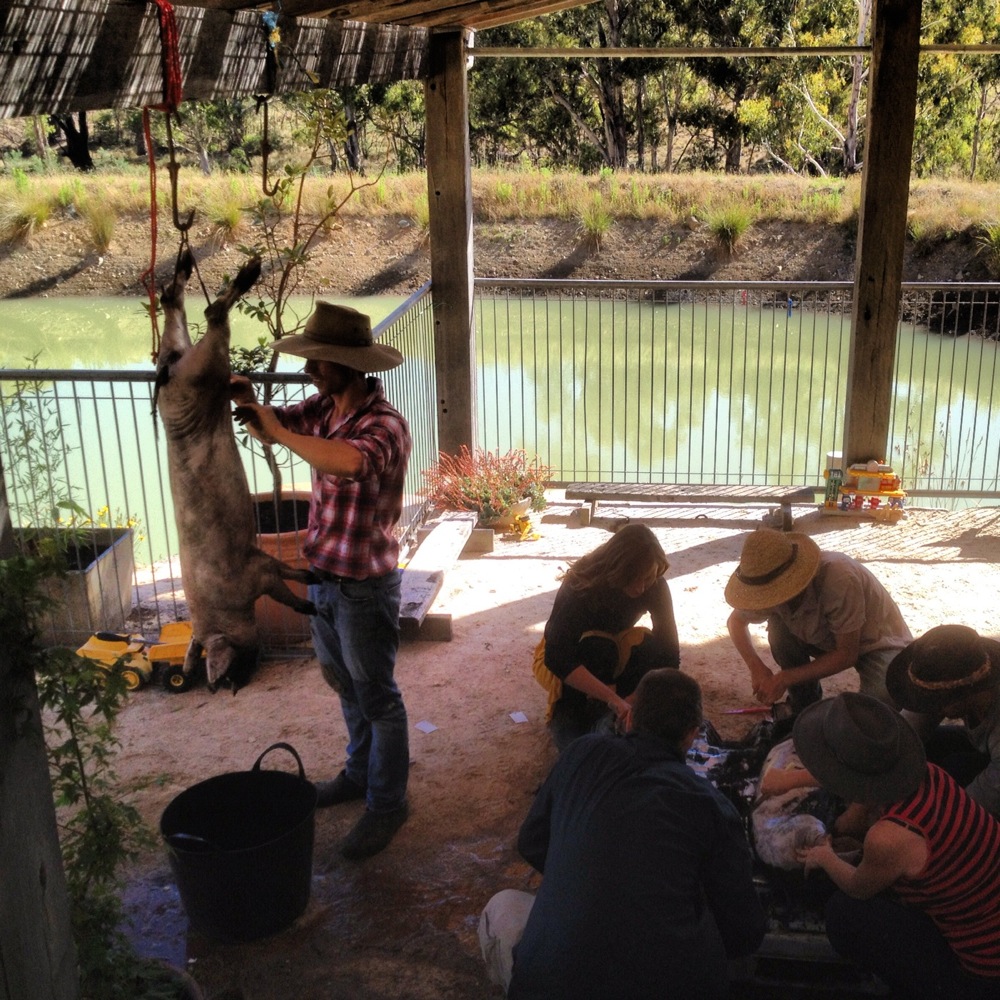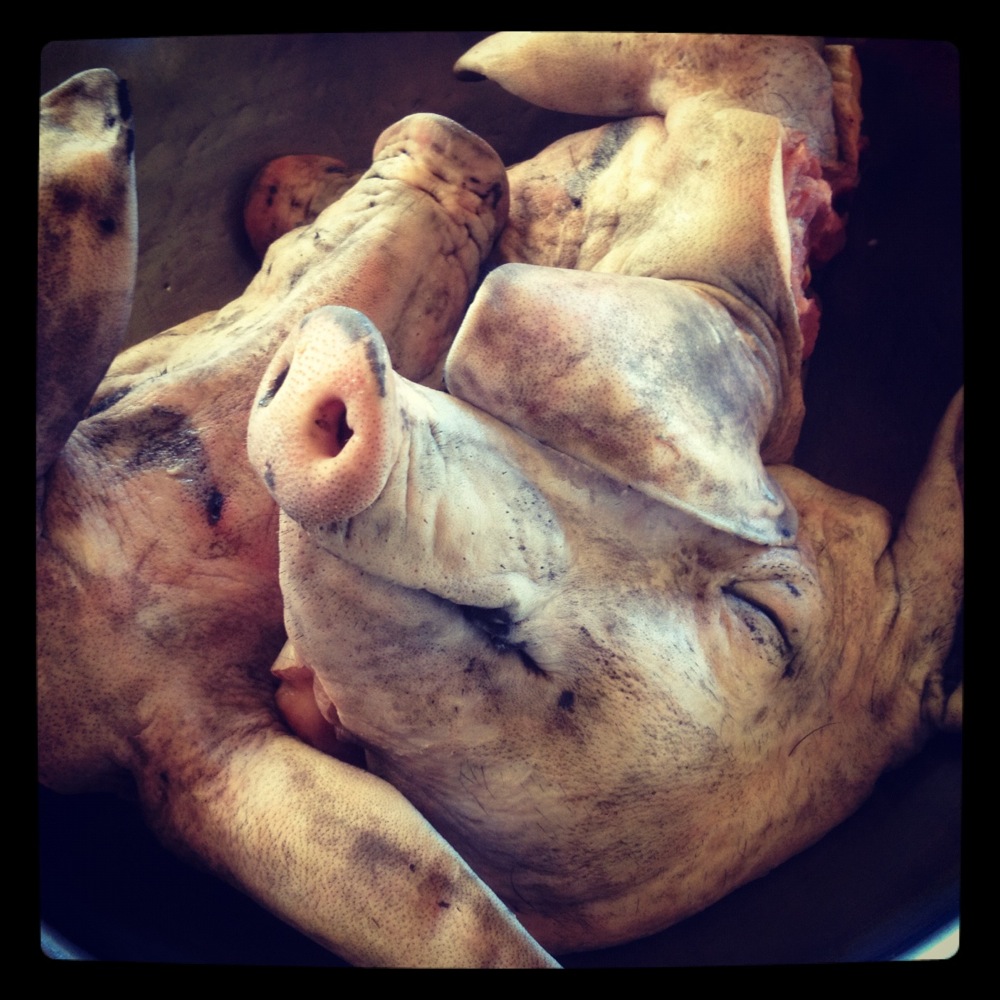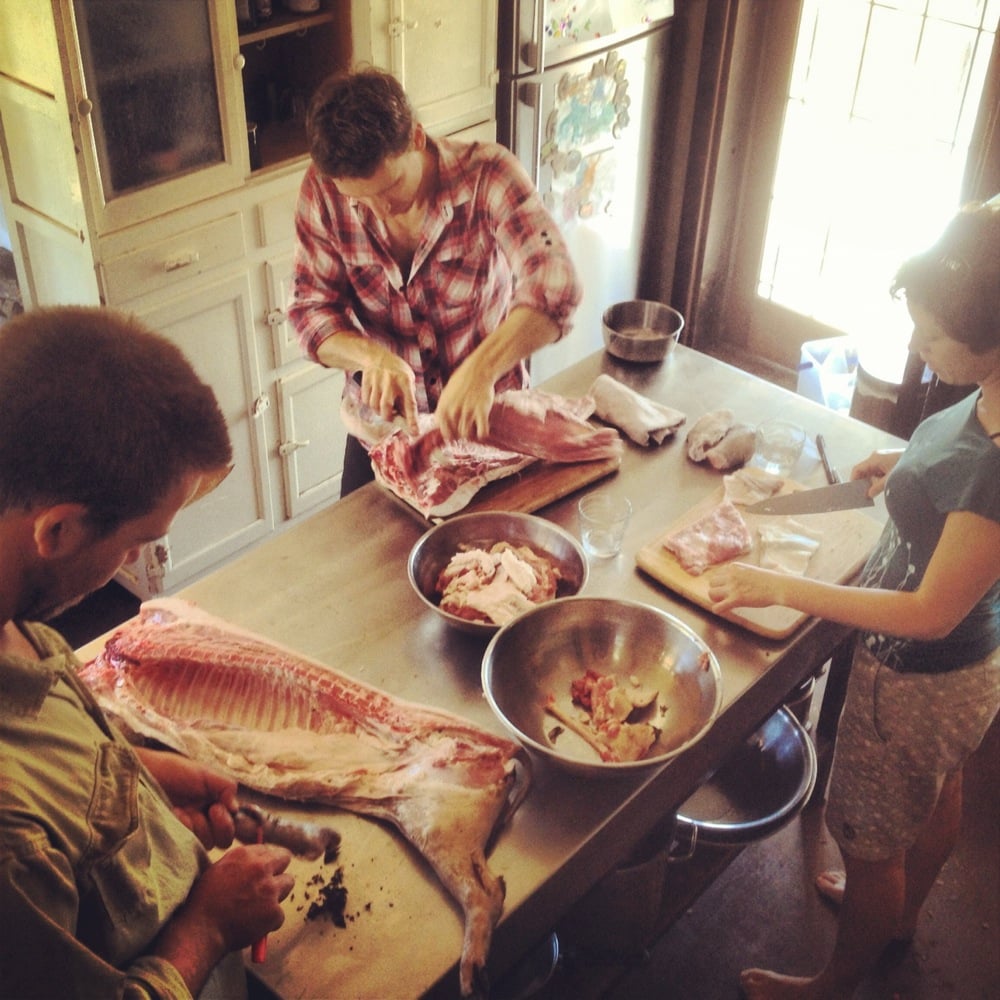This week marked a big step for us at Milkwood Farm, as we got the chance to follow-through on the stewardship of our pastured pigs by taking them all the way to the plate.
In the spirit of honoring both life and death, we wanted to make the most of our pigs, and learn how to process every single part of them so that nothing need be wasted. An intense two days of learning and considering what it means to be a part of the full cycle of life.
* A note that this post contains pictures of recently dispatched pigs in the process of becoming nourishing food. If this isn’t your thing, please check out our many other posts and resources.

Pre-dispatch scratch, followed by a bowl of breakfast, during which this pigs life came to a sudden halt without him even knowing it.
Former Milkwood intern, chef and all-round fabulous person Olivier Sofo generously took two days off from his busy schedule to join us at Milkwood Farm and step us through the processes involved. While we’ve killed and processed chickens and sheep before, this time we wanted to do the full deal that is a pig harvest.
I was proud to be part of this process most of all because it was so respectful. The pigs, which Floyd had raised here at Milkwood Farm, each got a head scratch and a bowl of breakfast, then while they were eating, were stunned and dispatched without so much as a squeak. A good life and one bad day.
Once the slaughtering was done, it was all hands on deck. Scalding, scraping, butchering and processing. We took 2 days to deal with three young boars, during which time Liv (Olivier) showed us the ways of terrines, blood sausages and head cheese for starters.
Yes, it was confronting. There’s a lot of new smells, new skills, new emotions and new sights involved in this task that 3 generations back would have been just a part of the yearly cycle for most families.
Nowadays we are just so removed from life and death and the earth that this was a very Big Thing, even for us who live on a farm, know how to process a chicken and in general consider ourselves fairly well earthed in what being ethical omnivores means.
I didn’t grow up around this stuff. I grew up around packets of meat and veggies from the supermarket, with supplementary passionfruits from the back fence.
While I love eating pork occasionally (if it’s had a good life), I needed to know. I needed to know if I was able to be a part of the full cycle, if the means justified the ends. What If i couldn’t hack it? Should that mean that I have no business eating that food?
It might be overly simplistic to say that unless you are prepared to kill it, then you shouldn’t eat it. There’s a darn fine argument for the idea that animal killing and processing is part of a cultural or community context, and just as we don’t all need to know how to make chairs, neither do we all need to be intimately involved with killing the animals we eat, and that the important thing is that it is done respectfully and ethically within a sustainable system, not whose hand is on the gun or knife.
Be that as it may, i needed to know if i was up for it. I think we all did. And we all learned a lot about ourselves in the process.

Whisking the blood with salt to prevent coagulation, so it can be used to make blood sausage. This has to be done immediately after slaughter.

The caul, a fatty membrane that wraps the stomach. Usually regarded as wastage but which can be used to wrap terrines etc. The amazing dendritic patterns of life are everywhere.

Harvest lunch after processing the first pig. We had a cake in honor of the pigs lives and toasted them roundly.

Why to process pigs at home. The total ‘wastage’ from one pig, apart from the bones and lungs/stomach. If this was the case for every pig that was eaten, we’d be able to nourish many, many more people…

Cooked and fried blood sausage, Liv’s sourdough and Kirsten’s tomato relish made from last year’s market garden bounty. A tribute to thrift, life and nourishment.
In the tiny house fridge is now head cheese, as well as terrine made from the livers/hearts/tongues, blood sausages, skin, ears, mince for sausages and other assorted bits. Aside from processing the offal, Liv of course also cut up the pigs themselves, most of which are now packed into a very full freezer and awaiting their appointed meals.
This process brought up a lot of things for many of us, most of all just how good a death can we give animals we care for. Because this is the final act of care, in my mind. And putting them on a trailer and shipping them four hours by road to the abattoir and then leaving them at the door just doesn’t compare as an act of stewardship.
While I’m not saying that it’s possible to dispatch all animals in this way, especially on a commercial scale, I think it should be done this way if we can possibly manage it.
Embracing your food from source to plate does a lot for your respect and appreciation of every dish devised from that animal, and also for your understanding of life.
Big thanks to Olivier Sofo for coming to teach us the ropes so generously, and to Floyd, Gigi, Michael, Lawrence, Linnea and Jeremy for all their efforts over these two days of pig. It was an honor to be a part of this with you all.
So there you have it. A huge experience that we will repeat seasonally at this farm as long as we live, and be grateful to be a part of. Our crew and families will be nourished by these pigs for months to come, and we all have a renewed appreciation of meat and what it means to eat it.
Particular huzzah’s to Farmstead Meatsmith and Farmrun, and to their work as described in Generosity as a Strategy for Survival. These crews’ attitudes and advocacy around home-processing of animals and the inherent ethics of such really boosted our confidence to get on with this aspect of re-skilling, and to talk about it with you.
Also big thanks to Joel Salatin and all at Polyface Farms for their advocacy around raising ethical farm-processed meats and the benefits to everyone (including the animals), which has also been a huge influence on our thinking these last few years.
Join us for Joel Salatin Masterclasses at Kiama in February…
>> More posts about pigs and food at Milkwood
**Just a note that, obviously, this post is about pigs, eating meat and the experience of home-processing. Any comments that are attacking or rant-like won’t be approved. We’ve had many robust debates about the ethics of meat eating over the years and when that’s the conversation we’re happy to have it.
This post and its conversation, however, is about learning to be ethical omnivores, and I’ll be moderating the comments if necessary to keep that conversation on track. Cheers.



















There is a theory out there that without meat we humans would not have developed the brain power they have. This is based on the calories required and food available to supply those needed calories. We are designed to be omnivores 🙂
Evolutionarily speaking, Alex. However, this argument is often used as a moral justification to continue eating meat. Thus, the question we must consider: If we stopped eating meat are we going to devolve? The answer is of course no. Meat was good for us at a vital stage of our evolution–it was vital to our species continuity. However, the necessity is gone. A well-balanced vegan diet is perfectly healthful.
Paul – do you have a link to a ” A well-balanced vegan diet is perfectly healthful.” ? I would like to assist my regular Vegan WWOOFers towards this aim – thanks.
Well done! We had a hangi ( Pig and yearling) here at CW last Saturday.
Agree with you on just about all points. I’m odd Blood Sausages – to salty for me.
keep well!
max
Great post and something I hope to do over the next few years. First step tho is to raise said piggy and get the butcher to do it. I think knowing that its my piggy on the table will be rather a large first step! Might try some young rooster and quail first! Love what you guys are doing! And look forward to your posts.
In your researching all of this, what have you found to be the fastest and gentlest way of killing the larger animals? I’m rather confident I could swiftly dispatch something smaller like rabbits and chickens if needed, without undo pain involved. But one of my reasons for hesitation in raising larger animals is my ability to end it swiftly and humanely. On that note, I’d rather not get extremely specialized tools, as I always aim for multipurpose ones.
Thank you!
Claire we stunned them with a .22 rifle shot, then used a knife to cut their throat, bleeding the blood directly into a bowl for later use so it wasn’t wasted.
And by “stun” we mean instantly destroying the frontal cortex of the brain. Our little friends never suspected a thing… a nice little scratch, a yummy breakfast served then…. nothingness. Instantaneous transition.
Excellent, respectful post. For those thinking about doing this themsleves, I’d highly recommend what Nick and Kirsten did – get someone with experience to show you how to do the slaughtering and the breakdown of the animal. You can’t do it well just from reading The Complete Book of Self Sufficiency. It’s trickier than you think and I for one wouldn’t want to stuff up the first part of the process (the kill). If you don’t have an experienced friend, get a home butcher around to do the job. They’re all super busy (you’ll probably need to do a couple… Read more »
Respect to you! Did I understand correctly you didn’t use the bones? I’m sure there’s plenty of uses for them too…
Well most of the bones are in the cuts of pig now in the freezer… Except for some which went to the farm dogs due to our inability to make bone broth on top of everything else at once 🙂
Ah! Yes, I was going to suggest bone broth 🙂
I love and appreciate how respectful and kind all of you were to honour these animals and their part in your lives. I am very grateful to you for sharing this inspiration and fine example with us 🙂
Well done, not sure I have the strength to do that, yet, but working my way there slowly, slowly, slowly.
Excellent post. I love the Farmstead Meatsmith videos (found from your linking to it), and butchering/ smallgood making are both skills my husband (and myself) are aiming for in the new year, along with him starting to bowhunt (feral species). I currently pressure can stocks, and meat meals, but being able to make our own salami, bacon etc. would be so useful too. Thank you for sharing this experience with us all.
having toured abattoirs and field dressed pigs myself iknow which is the least traumatic to the animals more power to you i enjoyed the field day have afruitful Christmas cheers David
I like that you made them a cake!
What I luv about u guys are..there’s no right ravers..just people doing the right thing & respecting the animals, soil, plants & each other & trying to drag the rest of the populace along for the ride or at least giving them the option..this “pig thing” has been very well documented & the response is positive from all..thank you for being such educators & I’m soooo jealous of yr cooks & their wonderful recipies!!..Have a good break & look fwd to catching up on all the news when yr back on deck again..Best wishes from the Gold Coast..xx
Thanks for the details guys. We’re rearing our third batch of piggles at the moment (two porkers and two baconers for two families) and use the same despatch method as yourselves, although our porkers are grown larger than yours. We keep the gilts for baconers to avoid boar taint and grow them (fairly slowly) to about 8 months. They all get fattened at the end of summer and into autumn on the corncobs that bugs get into, pumpkins, windfalls and bruised fruit. As we now have two Jersey cows they get plenty of whey and skimmed milk also. Putting a… Read more »
Oh Carole, you’re making me hungry!
This is a fabulous post….
We felt the same when killing and processing our first chickens… it was a BIG thing but a journey we felt we needed to travel and something we felt we needed to do and learn.
Loved the post. Congrats on making it possible!
As a cannibal, I totally agree with you about killing (or as I like to say, “harvesting”) my food: the important thing is that it is done respectfully and ethically within a sustainable system. Glad to see we’re on the same page.
Great post! We are just starting our sustainable journey and attempting some level of self sufficiency, starting with chickens when they begin to make neighbour-disturbing noises (in the next few weeks I think). I love the fact that you thanked your pigs too and made so very much of them as to waste nearly nothing. That is true respect for them and their lives.
Wonderful read! I have to ask, were the bones used for stock? (They were mentioned as waste.) Roast the bones, use for stock, when finished try and crush and feed to laying hens.
Fantastic work guys! We’re about to embark on the same life cycle journey in ethical meat here at White Stone Farm, so your post has given me some strength. I too grew up with packaged meat as a girl from the ‘burbs, so am appreciating learning a new appreciation for meat, the life it takes to get to the plate and most of all, giving something that you have cared for a humane and respectful death. Thanks for sharing. 🙂
I don’t think cannibalism and this post have anything in common, mijnheer…
But thank you guys for sharing this story. I admit seeing the pig getting his scratch before being dispatched nearly made me cry, but it also made me realise just how much I need to go through this process, otherwise (as you say) what business do I have eating meat? Might as well admit where it comes from, and pay these animals the respect they deserve. Well done!
I get the .22 for a large animal. What do you believe is the best way for a smaller piglet? I have done one with a knife without stunning and won’t do that again. They dart around too fast to shoot and I don’t have a gun anyway. How did you do your lambs?
we’d still use a rifle to the head, while it was eating its breakfast. Same with sheep (the lambs are obviously not actually ‘lambs’ when they’re harvested, but dont have adult teeth yet)
I’m a little emotional at the moment anyway, so this post made me cry–because I’m so impressed with your respect for your animals. I like your turn of phrase–“the final act of care”. And I very much agree that eating an animal you raised increases your level of respect for the food exponentially. Bravo.
Hmmm, Reading how you documented your heart-centered ethical approach to turning your pigs into food and utilizing (honouring) as much as you could of them was a very emotional experience. My family kept cows, sheep, pigs, ducks and chickens all of whom went the same pathway named or unnamed onto the kitchen table of three families. We utilised most at highest usage but you were thorough.
I honour your sharing of what most folk don’t want to talk about or those who do can’t find someone who knows to ask.
Blessings, Satya